Now to show what the Polyhedral Pantheon might look like in practice. I have completed a worksheet and taken snapshots of it as I went.
Overall the sheet took less than an hour to complete, including storing it at different stages and in multiple formats (the Publisher file I was editing, plus PNG ‘screenshot’ and PDF printable version — which I now realize I probably don’t really need, since the PNG is quite readable and odds are good people won’t want to make copies of the PDF for themselves… ah well, there’s a couple minutes of my life I won’t be getting back).
Applying Polyhedral Pantheon Design
I came into this process with little idea of what I wanted out of the pantheon. I wanted things to make as much as as possible, with ‘obvious mismatches’ such as a Chaotic Evil god of Healing not included. I made multiple passes through the domain list, picking up groups of domains (alignments and elements were a couple of the first ones). In some cases there was a good fit between the domains chosen, in others they were pretty arbitrary, but overall I don’t think there is anything here too hard to explain.
If I wanted to get more creative I would probably nail down the ones I really want (such as the alignment domains, make sure I have covered the alignments I wanted) and just randomly selected from the rest. If I need to I probably can explain a Chaotic Evil god of Healing and a Lawful Good god of Death, and sometimes the unexpected combinations bring some very evocative ideas to mind.
Step 1: Alignment Domains
For this exercise I want all nine alignments provided, to show it can be done. Points A, C, L, N get Law, Good, Chaos, Evil domains respectively.
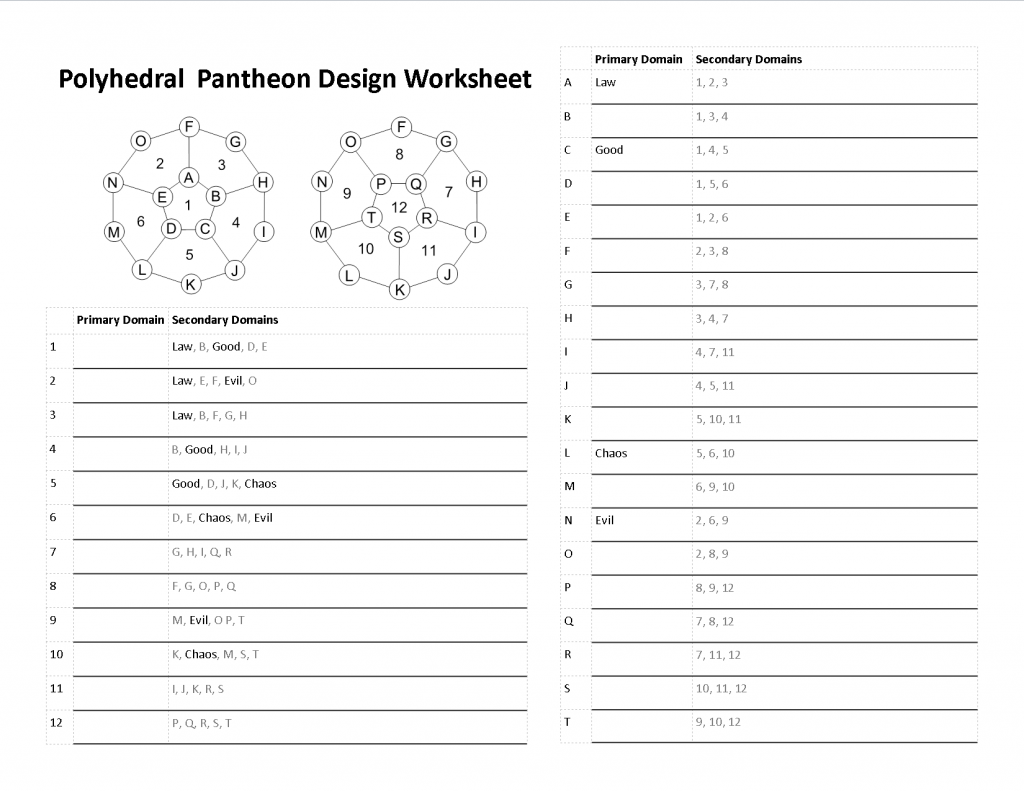
This gives me one core god of each alignment other than True Neutral, plus four True Neutral gods. The secondary gods clearly have each of the part-neutral gods covered, so I end up with the following alignment frequencies.
| Alignment | Core Frequency | Secondary Frequency | Total Frequency |
| LG | 1 | – | 1 |
| LN | 1 | 1 | 2 |
| LE | 1 | – | 1 |
| NG | 1 | 1 | 2 |
| TN | 4 | 16 | 20 |
| NE | 1 | 1 | 2 |
| CG | 1 | – | 1 |
| CN | 1 | 1 | 2 |
| CE | 1 | – | 1 |
This seems awfully rich in True Neutral gods, but bear in mind that this considers only alignments associated with the domains (and the assumption that a non-Good god will never have the Good domain). The other gods may have alignments but not provide access to the domains of those alignments; I don’t show those here. I worked out potential values for them based on proximity to other domains and gods. For instance, Point B is adjacent to Points A (Law) and C (Good), and is thus likely Lawful Good. Of the 16 secondary gods shown above as True Neutral, by this reasoning 8 are adjacent to at least one point with an alignment domain. Examination shows that six more are adjacent to faces associated with an alignment other than True Neutral. This suggests that of the 32 gods presented above, six might have no alignment tendency — considering only domains and adjacency.
Step 2: Alignment Personal Domains
I decided to establish some relationships between the ‘alignment gods’ and their personal domains.
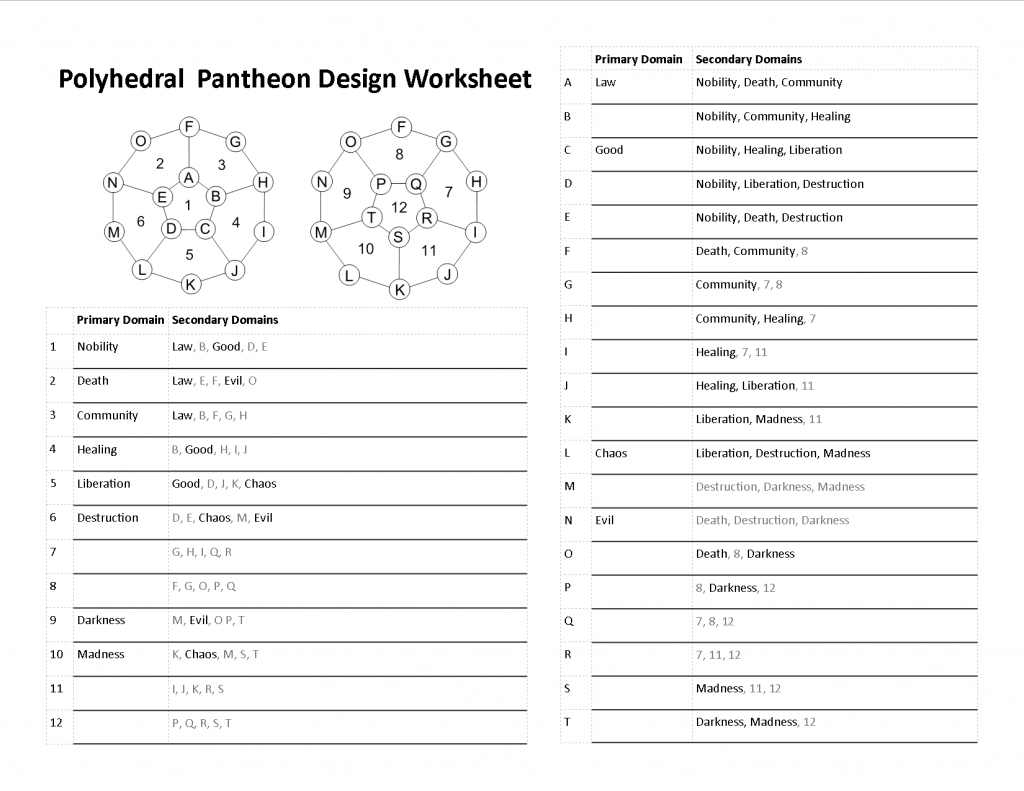
Already the worksheet is becoming fairly well-populated, and I’ve got some good hints as to what I might do with some more of the Point Domains.
Step 3: Elemental Domains
In fact, before I go any farther I want to make sure I’ve got the elemental domains covered. I could have done them earlier, but I didn’t have anything in mind so I wanted to see what was shaping up. I decided it might be interesting to have all major gods have an elemental influence, but only one, so I looked over the points available and the domains already associated with them and found a set I liked.
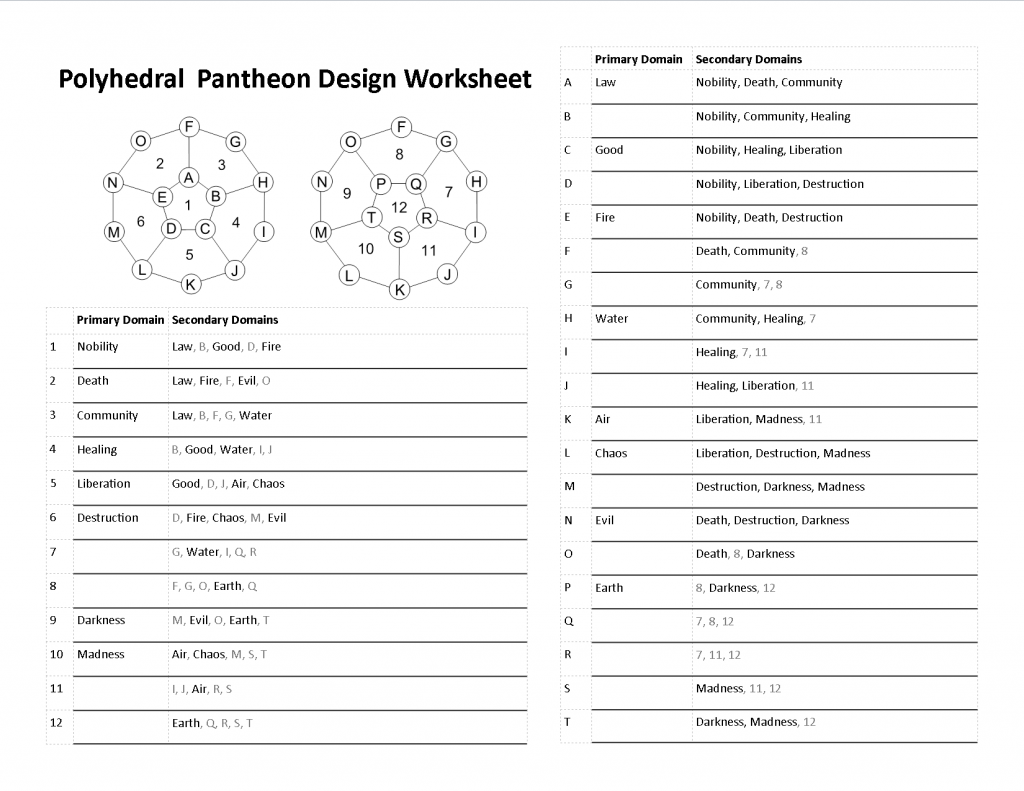
Looking over the associations I now have, I’m starting to get a feel for some of the gods. Point K (Air, plus Liberation and Madness) looks like it has some potential, Point N (Evil, plus Death, Destruction, and Darkness) looks pretty straightforward, and so on.
Step 4: Placing Points
I have covered some major points (alignments, direct associations with alignments, and elements), now it’s time to flesh out the rest. I have a few secondary gods with their secondary domains populated, I think I’ll fill in their primary domains.
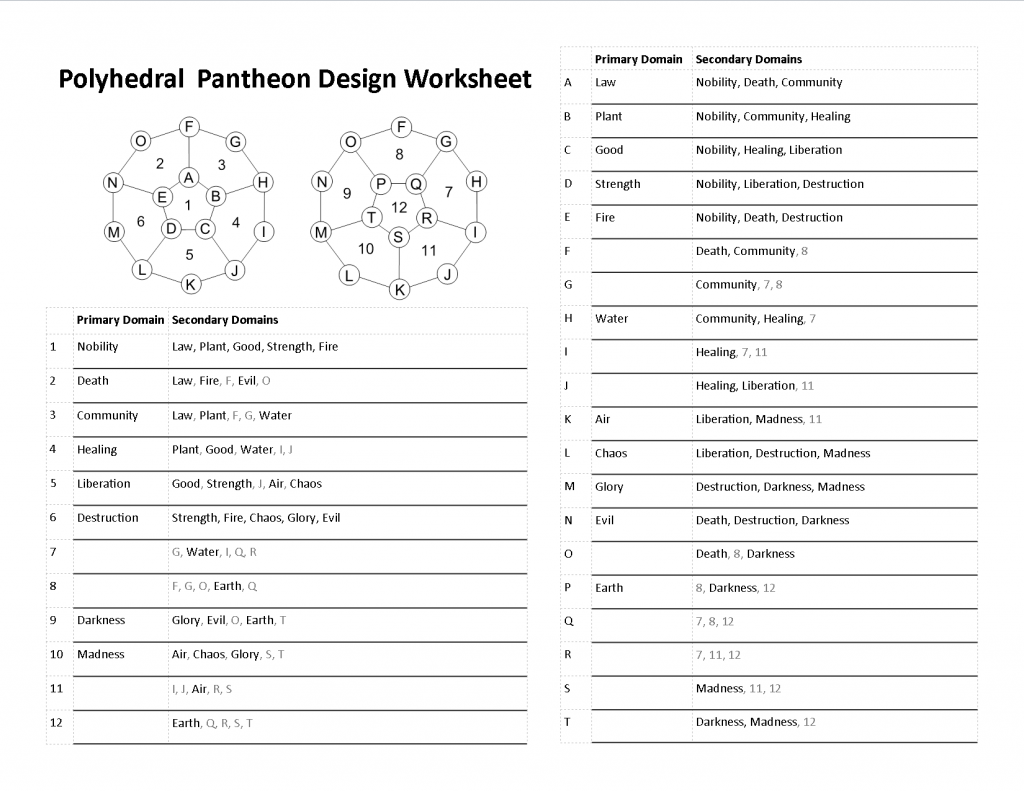
Point B gets ‘Plant’ to go with Nobility, Community, and Healing; Point D gets ‘Strength’ to go with Nobility, Liberation, and Destruction; and Point M gets ‘Glory’ to go with Destruction, Darkness, and Madness.
I get the impression this culture isn’t really fond of war and physical violence. Some of the core gods are now complete.
- Nobility is associated with Law, Plant, Good, Strength, and Fire.
- Destruction is associated with Strength, Fire, Chaos, Glory, and Evil.
These don’t look too unreasonable.
One thing I rather like about this model it is how various domains can be associated with opposing values — Nobility is Lawful Good, and associated with Strength and Fire… but Strength and Fire are also associated with Destruction, which is Chaotic Evil.
This really appeals to me. Let’s see what else happens.
Step 5: Placing More Points
I’m starting to run out of easy placements, so I’m becoming a little more arbitrary and just trying to avoid really bad conflicts.
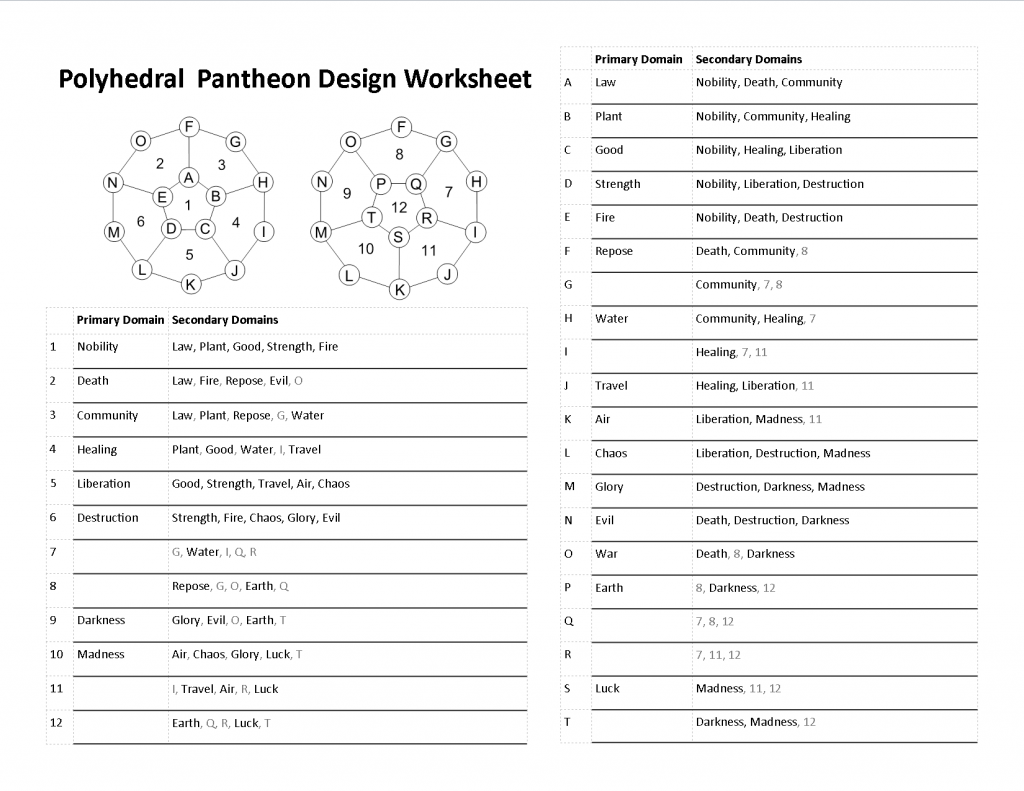
Repose has Ancestors and Souls as subdomains, so it seems to be that Death and Community would be a good association. I put it on Point F.
War is not a really popular thing here, so I associated it with Death and Darkness at Point O.
Fools can be lucky, and I don’t want it to be too dark, so I put it with Madness at Point S. I don’t know yet what else will go there.
Ever since I saw Healing and Liberation together I have pictured an order of itinerant healers, so I put Travel at Point J.
Step 6: Finishing Off
I notice that Q and R are completely unpopulated! They share Faces 7 and 12, which are lightly populated, and I haven’t even touched on intellectual domains yet.
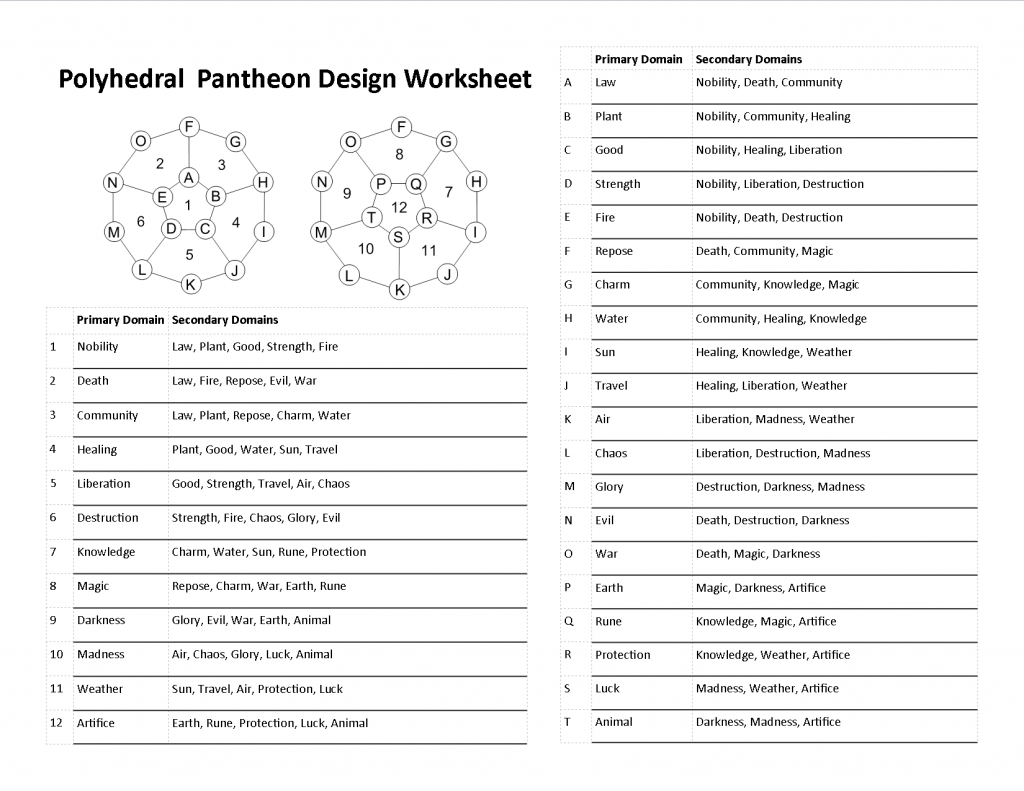
I perhaps should have split this into two pieces, but it’s done now.
Knowledge, Magic, Artifice, and Rune sound like they might be close together (but they don’t need to be! This is almost cliche what I’m doing here), so put Knowledge at Face 7, Magic at Face 8, Artifice at Face 12, and Rune at Point Q so there is a god with all four parts.
Face 11 can have Weather (to go with Travel, Air, and Luck), and Sun would be a good fit with Weather, so put that on Point I (to go with Healing and Knowledge).
That gives us all faces populated, so Point G can have Charm to go with Community, Knowledge, and Magic; Point R can have Protection to go with Knowledge, Weather, and Artifice (an odd set perhaps, but let me think about it); and Point T can have Animal to go with Darkness, Madness, and Artifice (another odd set, but it feels like it could go somewhere).
I never did find a use for the Trickery domain.
Final Domain Sets
In the end I have the following domain sets for the gods, and tentative alignments.
Core Gods
| Face | Align | Primary | Secondary Domains |
| 1 | LG | Nobility | Law, Plant, Good, Strength, Fire |
| 2 | LE | Death | Law, Fire, Repose, Evil, War |
| 3 | LN | Community | Law, Plant, Repose, Charm, Water |
| 4 | NG | Healing | Plant, Good, Water, Sun, Travel |
| 5 | CG | Liberation | Good, Strength, Travel, Air, Chaos |
| 6 | CE | Destruction | Strength, Fire, Chaos, Glory, Evil |
| 7 | – | Knowledge | Charm, Water, Sun, Rune, Protection |
| 8 | – | Magic | Repose, Charm, War, Earth, Rune |
| 9 | NE | Darkness | Glory, Evil, War, Earth, Animal |
| 10 | CN | Madness | Air, Chaos, Glory, Luck, Animal |
| 11 | – | Weather | Sun, Travel, Air, Protection, Luck |
| 12 | – | Artifice | Earth, Rune, Protection, Luck, Animal |
Secondary Gods
| Point | Align | Primary | Secondary Domains |
| A | LN | Law | Nobility, Death, Community |
| B | (LG) | Plant | Nobility, Community, Healing |
| C | NG | Good | Nobility, Healing, Liberation |
| D | (C)N | Strength | Nobility, Liberation, Destruction |
| E | (LE) | Fire | Nobility, Death, Destruction |
| F | (L)N | Repose | Death, Community, Magic |
| G | – | Charm | Community, Knowledge, Magic |
| H | – | Water | Community, Healing, Knowledge |
| I | – | Sun | Healing, Knowledge, Weather |
| J | N(G) | Travel | Healing, Liberation, Weather |
| K | (C)N | Air | Liberation, Madness, Weather |
| L | CN | Chaos | Liberation, Destruction, Madness |
| M | (CE) | Glory | Destruction, Darkness, Madness |
| N | NE | Evil | Death, Destruction, Darkness |
| O | N(E) | War | Death, Magic, Darkness |
| P | – | Earth | Magic, Darkness, Artifice |
| Q | – | Rune | Knowledge, Magic, Artifice |
| R | – | Protection | Knowledge, Weather, Artifice |
| S | – | Luck | Madness, Weather, Artifice |
| T | – | Animal | Darkness, Madness, Artifice |
Where the alignment is surrounded by parentheses it is because the alignment comes from an adjacent Point, not directly. In addition, some of the unaligned above might actually have tendencies derived from adjacent faces (such as Animal — Darkness is NE, Madness is CN, so there could be a tendency toward CE.
Closing Comments
For an hour’s worth of effort (actually writing this post has taken rather longer than working out the material to go into it), I think there is some workable material above.
I had said initially that the Pathfinder domain set is a close fit, I’m coming to the conclusion that more domains really would be helpful when trying to place them specifically. I was running out of good choices toward the end. On the other hand, they look like they might make for some of the more interesting options in the long run. ‘Rune + Knowledge + Magic + Artifice’, while thematically good, has been done so many times that I question how interesting it really is.
Useful, no question, but interesting? Perhaps not so much. It might have been better to put Knowledge, Magic, and Artifice (and possibly Rune) on points instead of faces. Then you might have one god with all of them, but no more than two on any of the secondary gods. On reconsideration this might have been a better choice — especially if you make the face domain an interesting one.
One consequence of the lists above, though, is that there is a sense of homogeneity to the domain sets. On one level that is a good thing because it helps establish relationships between the domains (Death and Destruction go together, or might be split and combined with Fire or Evil… definite connotations there in the minds of those affected), but on another it might be seen as too similar, and thus either redundant or boring.
This is where the next step comes in, that I didn’t do here today. Pathfinder has subdomains that tweak the spells and domain powers of the primary domains. This may be enough to start to draw differences between gods with similar domain sets. I’ll explore this in the next post.
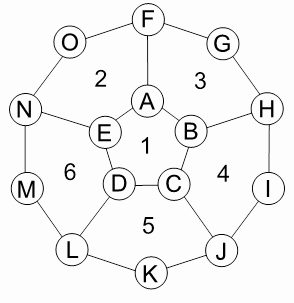
I’ve got a post on the religions and gods in my new setting coming up. I’ll use this to help me. Thanks for sharing the ideas.